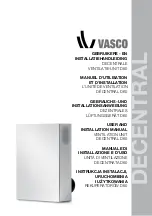
37
Installer Selectable High Speed Settings
CAUTION
Risk of Carbon Monoxide Poisoning and/or Explosion.
Can cause injury or death.
Combustion and flue gases from heating appliances must
never be allowed to enter living spaces.
ERV/HRV unit must be properly balanced to prevent
negative pressure in structure. Negative pressure can
cause back−drafting of combustion gases in other
household appliances such as Gas Furnaces, Oil
Furnaces, Hot Water Heaters, Wood Stoves, Fireplaces,
etc.
(5-Port HRV models only) Defrost cycles will cause
negative pressure in equipment room. Install ductwork
and route to areas that do not contain appliances with
vented combusted gases.
Never connect a return or supply duct to other heating
units such as fireplaces, wood stoves.
The circuit board on this unit has adjustable DIP switch
-
es to select the maximum air flow at high speed. Adjusting
high speed can be useful to accurately satisfy the calculat-
ed ventilation rate. The chart below indicates how to adjust
high speed to high speed 4 and high speed 3. Refer to the
specification pages in the manual for the air flow rates for
speeds 5, 4 and 3. The factory setting is high speed 5.
NOTE:
Low speed is not adjustable.
Table 18. High Speed Settings
Description
Switch
Position 1
Switch
Position 2
Switch
Position 3
Switch
Position 4
High Speed 5
(factory default)
Factory setting
ON
Leave on
factory setting
ON
ON
High Speed 4
OFF
ON
High Speed 3
ON
OFF
ERV/HRV Connected with an Basic and
Deluxe Control
Balance the HRV or ERV at High speed using door port
balancing chart or pitot tube to required CFM making sure
the system blower is on at high speed.
The orientation of the circuit board in the electrical
box may differ from this illustration
DIP switches 3 and
4 in ON position
(factory setting)
Functionality of DIP switches 1 and 2
DIP 1 ON
(factory setting)
DIP 1 OFF
Defrost cycle enabled
DIP 2 ON
DIP 2 OFF
Damper defrost and fan de-
frost models
Recirculating Defrost models
Defrost cycle disabled
Figure 44. Speed Settings
CAUTION
Potential Condensation Damage. Condensation can
cause damage to building structures.
Ensure proper ERV/HRV balancing. Excessive positive
pressure in a home can force warm/moist indoor air
through wall insulation towards external walls. In cold
weather, this may cause unseen condensation to collect
on the interior surfaces of external walls.
Содержание ERV5-130
Страница 36: ...36 Figure 43 Wiring Diagram HRV5 270 TPD ECM...
Страница 60: ...60...
















































